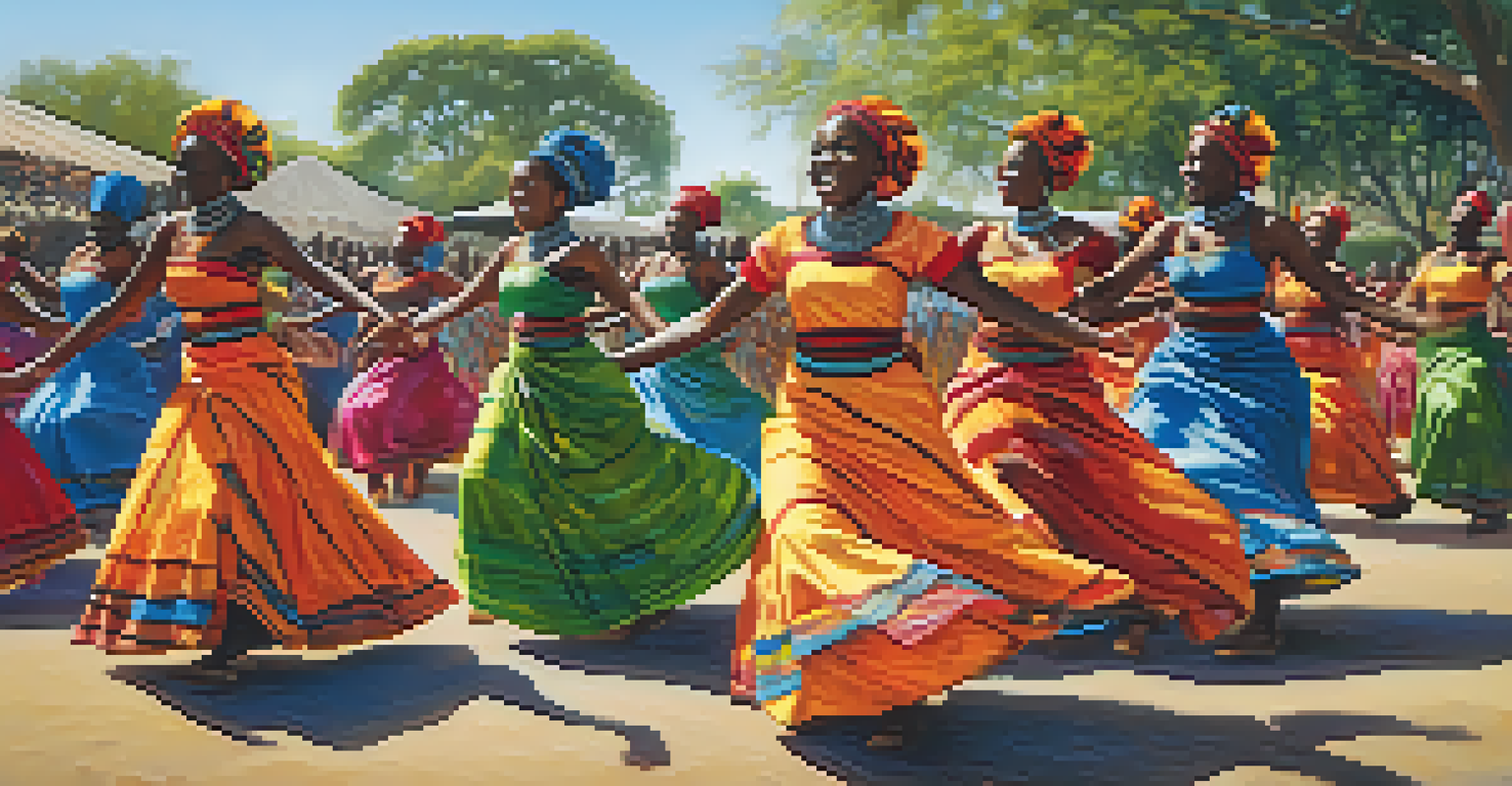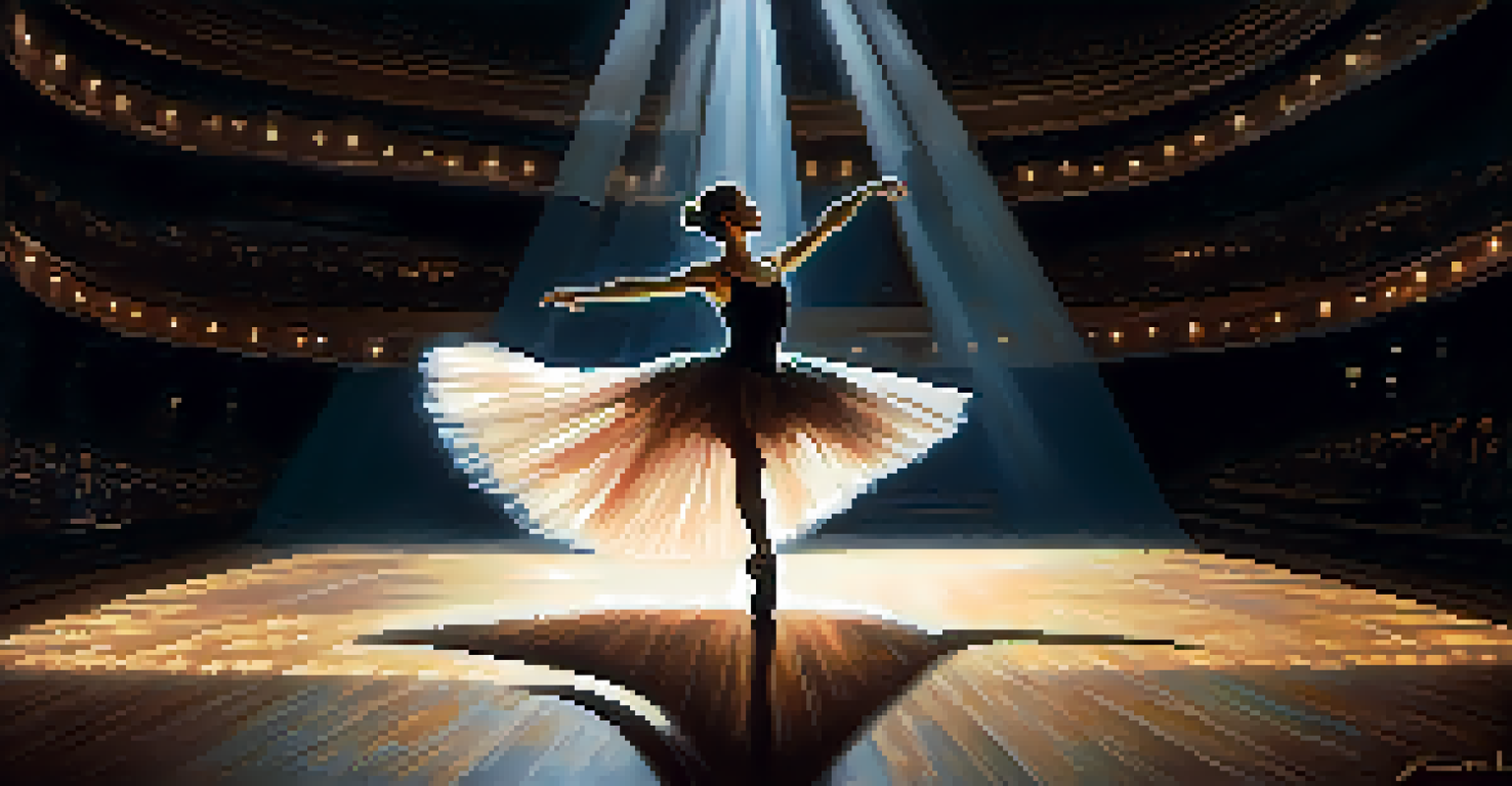Interpreting Dance: A Non-Verbal Dialogue Among Dancers

The Essence of Non-Verbal Communication in Dance
Dance is often described as a universal language, transcending words and barriers. Through movement, dancers convey emotions, stories, and ideas that can be understood by anyone, regardless of their background. This non-verbal communication is what makes dance so powerful; it allows connections to be formed without the need for spoken language.
Dance is the hidden language of the soul.
For instance, a simple twirl can express joy, while a slow, grounded movement may convey sorrow or contemplation. Each gesture, each step, tells a story that the audience can feel and interpret, creating an intimate dialogue between the dancer and the viewer. This essence of dance is what captures the heart and spirit of performances around the world.
Moreover, the beauty of this non-verbal dialogue lies in its subjectivity. Each person may interpret a dance differently, influenced by their experiences and emotions. This variety adds depth to the art form, inviting audiences to engage in their own interpretations.
The Role of Body Language in Dance
Body language is a critical aspect of how dancers communicate with each other and their audience. Every movement, from a raised arm to a subtle shift in posture, carries meaning. Dancers learn to read each other's body language to synchronize their movements and create a cohesive performance.

Imagine a pair of dancers performing a duet; they rely on the smallest cues to connect with each other and maintain their flow. If one dancer leans slightly forward, the other might instinctively follow, creating a seamless exchange that feels natural and spontaneous. This interplay showcases the importance of trust and intuition in dance.
Dance as a Universal Language
Dance transcends verbal communication, allowing emotions and stories to be shared through movement.
Additionally, body language can evoke powerful emotions in the audience. A dancer's posture, facial expressions, and even the intensity of their movements can collectively stir feelings of excitement, sadness, or nostalgia. This ability to convey emotions through body language is what makes dance such an evocative art form.
Musicality: The Dancer's Conversation with Sound
Musicality in dance refers to how dancers interpret and respond to music through their movements. It's not just about dancing to the beat; it’s about embodying the music and allowing it to guide the performance. This connection between music and movement is a crucial aspect of the non-verbal dialogue in dance.
The body says what words cannot.
When dancers move in sync with the rhythm, it creates a harmonious relationship between sound and motion. For instance, a sharp, staccato piece of music may prompt quick, precise movements, while a slow, melodic piece might inspire sweeping, fluid motions. This interplay enriches the storytelling aspect of dance, drawing the audience deeper into the experience.
Furthermore, musicality also enhances the emotional impact of a performance. Dancers often use the nuances of the music to amplify their expressions, creating a richer narrative. This synergy between music and dance is what makes a performance truly captivating.
Improvisation: Spontaneity in Movement
Improvisation in dance is where spontaneity shines, allowing dancers to express themselves in the moment. This non-verbal dialogue becomes even more profound when dancers deviate from choreography, relying on instinct and emotion. It’s a dance of discovery, where movements emerge organically.
In an improvisational setting, dancers often respond to each other’s movements, creating a dynamic conversation that evolves over time. Each dancer contributes their unique voice, resulting in a collective expression that’s both personal and shared. This practice can lead to unexpected and beautiful moments that wouldn’t occur in a structured routine.
Body Language Enhances Connection
Dancers rely on body language to synchronize movements and create an intimate dialogue with each other and the audience.
Moreover, improvisation invites vulnerability, as dancers open themselves up to the flow of creativity. This willingness to explore and communicate through movement fosters a deeper connection among performers, making the experience authentic and engaging.
Cultural Influences on Dance Communication
Dance is deeply influenced by culture, which shapes how movements are created, interpreted, and communicated. Different cultures have distinct styles and traditions that inform the way dancers express themselves. This cultural lens adds layers of meaning to the non-verbal dialogue in dance.
For instance, traditional African dance often emphasizes community and storytelling, using movement to convey cultural history and values. In contrast, ballet may focus more on grace and precision, showcasing technical skill and individual expression. These cultural differences enrich the tapestry of dance as a form of communication.
Additionally, cross-cultural collaborations can lead to exciting new forms of dance, merging various traditions to create a unique dialogue. This blending of styles exemplifies how dance transcends boundaries, allowing for shared understanding and appreciation among diverse audiences.
The Importance of Connection Among Dancers
Connection among dancers is fundamental for a successful performance. Whether performing in pairs or groups, the ability to communicate non-verbally fosters unity and enhances the overall experience. This connection is often built through practice, trust, and a shared understanding of the dance.
When dancers are in sync, both physically and emotionally, it creates a powerful visual impact. Audiences can sense this connection, which transforms the performance from a series of movements into a cohesive narrative. It's this level of intimacy that draws viewers in and keeps them engaged.
Cultural Influences Shape Expression
Different cultural backgrounds inform the styles and interpretations of dance, enriching its non-verbal communication.
Moreover, the bond between dancers can be seen in their interactions on stage. A shared glance or a slight shift in weight can convey a wealth of meaning, further enriching the non-verbal dialogue. This intricate web of connections makes each performance a unique experience.
The Audience's Role in Interpreting Dance
The audience plays a crucial role in the non-verbal dialogue of dance. When watching a performance, viewers bring their experiences and emotions into the interpretation of movements. This subjective engagement makes each performance resonate differently for each individual.
As audiences observe, they may find themselves feeling a connection to the dancers, interpreting their movements in a way that relates to their own lives. For instance, a dancer’s portrayal of joy might remind someone of a personal triumph, while another may resonate with a depiction of heartache. This personal connection adds depth to the experience.

Furthermore, audience reactions can influence the energy of a performance. Applause, gasps, or silence can affect how dancers perform, creating a dynamic interplay between the performers and the audience. This relationship highlights the importance of viewer interpretation in the overall dialogue of dance.